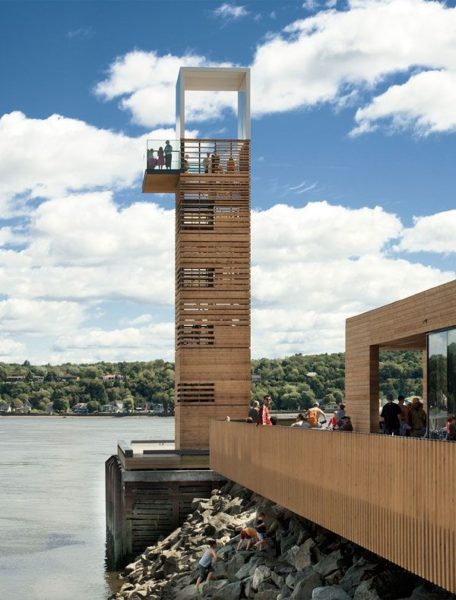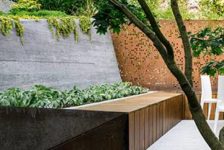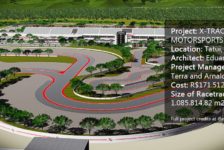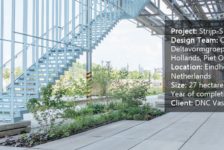National Fitness Campaign Fitness Court, by NewDealDesign, in Marina Green, San Francisco. Do you have a gym membership? If so, how often are you able to motivate yourself to arrive at the doorsteps of your gym for a hardcore workout session? Here comes the big question: Have you actually achieved your fitness goal? Gyms have become so standardized these days that they have become more of a marketing tool for consumerism. With so many of us having the odd rarely used gym membership, being too busy, and feeling more guilty than fit, we have actually become blind to other solutions. But there are ways to get exercise and a better sense of well-being without dealing with pricey membership fees, travel costs, and mind-boggling use of gym equipment.
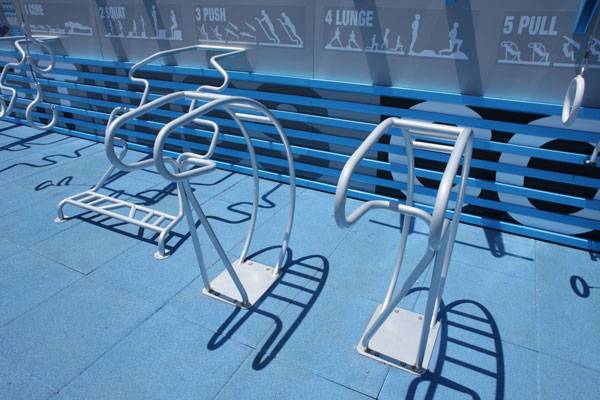
Credit: NewDealDesign LLC and the National Fitness Campaign
National Fitness Campaign Fitness Court
Let us introduce to you the Fitness Court. Like many other “courts”, such as basketball courts, it is an outside workout space dedicated for use by the community. The first of its kind is the National Fitness Campaign (NFC) court designed by NewDealDesign, which aims to tackle the personal, social, and physical barriers to working out in a gym.
The Vision
NFC is a social enterprise founded in 1979 by Mitch Menaged. By converting public spaces into outdoor circuit-training systems, a.k.a. Fitness Courts, the campaign is able to provide free and accessible workout spaces to the public. Communities can request the Fitness Courts to arrive in their area for free, and locals do not need to buy a membership. How? It follows Menaged’s idea of allowing businesses to advertise in the space. In turn, these businesses end up supporting community fitness — and gaining publicity in the process.

Credit: NewDealDesign LLC and the National Fitness Campaign
- How to Design a Landscape for Extreme Workouts: Part 1 Calisthenics
- How to Design a Landscape for Extreme Workouts: Part 2 Free Running
- How to Design a Landscape for Extreme Workouts: Part 3 Bouldering
Now, re-launching the campaign with this model in the 21st century, the new and improved NFC court has arrived in San Francisco, with the idea of opening 20 new courts across the United States in 2015 and 200 by 2017. Could this be a simply intelligent way of tackling obesity?
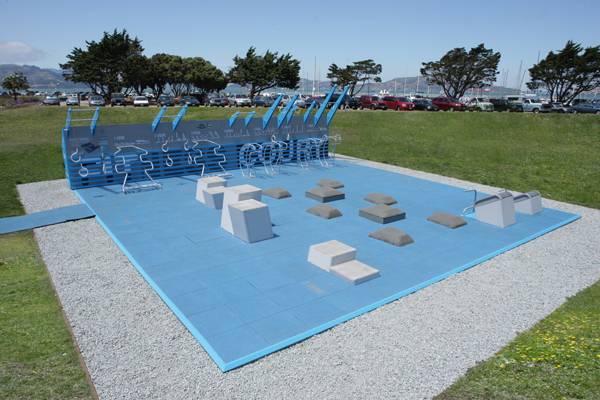
Credit: NewDealDesign LLC and the National Fitness Campaign
Re-thinking the Gym Experience
Concerns with such a vision lie in finding waterproof materials that are easy to transport and assemble. More importantly, how do you design a Fitness Court that mimics the gym experience, yet does it just a little bit better, offering equipment designed for a full body workout at all fitness levels? The innovative NewDealDesign has created a circuit-training-based court split into seven main movement areas, each of which targets different muscles. With 30 pieces of equipment, the design flows from one area to the next, allowing individuals or groups to use the court simultaneously. Moreover, the “perfect layout” is restricted to a single court, so the final design takes ownership of the space and is also able to maximize efficiency.
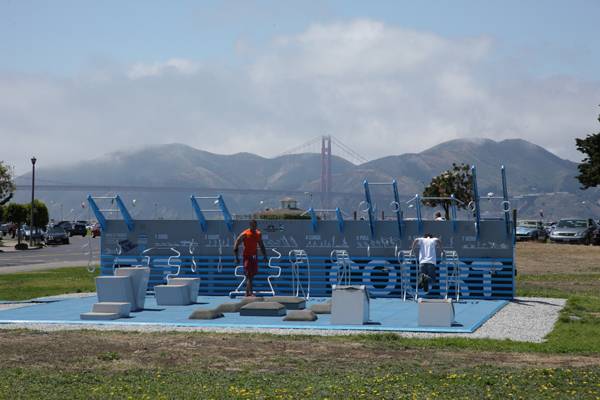
Credit: NewDealDesign LLC and the National Fitness Campaign

Credit: NewDealDesign LLC and the National Fitness Campaign
7 Movements in 7 Minutes
While gyms offer weight-training equipment, the NFC Court ditched the weights in favor of body-weight-resistance, high-intensity training. This opens up a workout routine to a more freestyle approach. The equipment is designed to work with various postures and grips. The structure’s single wall is used for many of the hardest exercises. Personal trainers involved in creating the prototype have created a seven-minute podcast as a guide to using the space. The seven movements correspond to the seven sections of their perfect layout: core, squat, push, lunge, pull, agility, and bend. According to Menaged, research shows that even seven minutes a day of working out can improve your health in the long run.
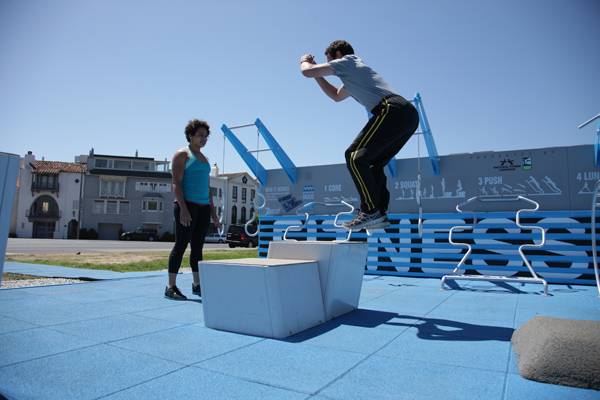
Credit: NewDealDesign LLC and the National Fitness Campaign
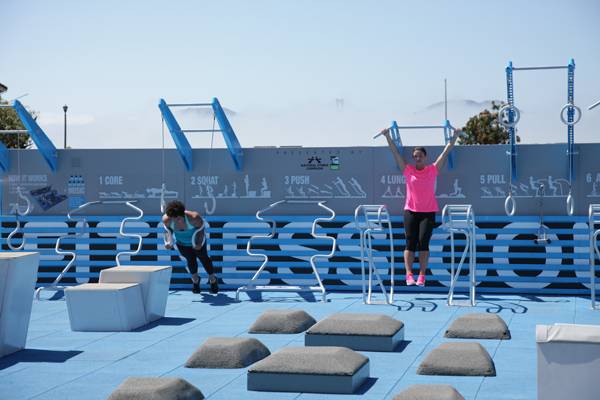
Credit: NewDealDesign LLC and the National Fitness Campaign
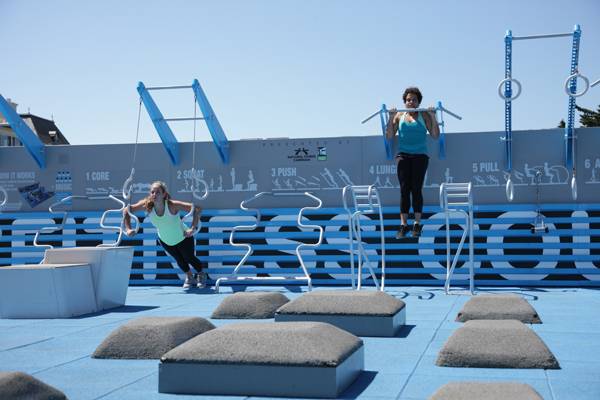
Credit: NewDealDesign LLC and the National Fitness Campaign
A New Style of Community Fitness
Whether you are a couch potato or a fitness maniac, the NFC Fitness Court model provides effective solutions to your excuses for skipping the gym. The seven movements in seven minutes approach is seemingly a tiny chunk out of our 24-hour day. And it can bring us together with our neighbors, encouraging our whole community to get and stay fit. Good health is not something we can buy, but efforts to achieve and maintain it can save us a great deal of trouble in the future.

Credit: NewDealDesign LLC and the National Fitness Campaign

Credit: NewDealDesign LLC and the National Fitness Campaign
WATCH: Fitness Court Promo
Full Project Credits For The National Fitness Campaign Fitness Court
Project: National Fitness Campaign Fitness Court Launch Date of Campaign: 1979-present Dimension of the Court: 32 feet by 35 feet Designers: NewDealDesign Location: Marina Green, San Francisco Recommended Reading:
- Urban Design by Alex Krieger
- The Urban Design Handbook: Techniques and Working Methods (Second Edition) by Urban Design Associates
Article by Win Phyo Return to Homepage
Published in Blog


